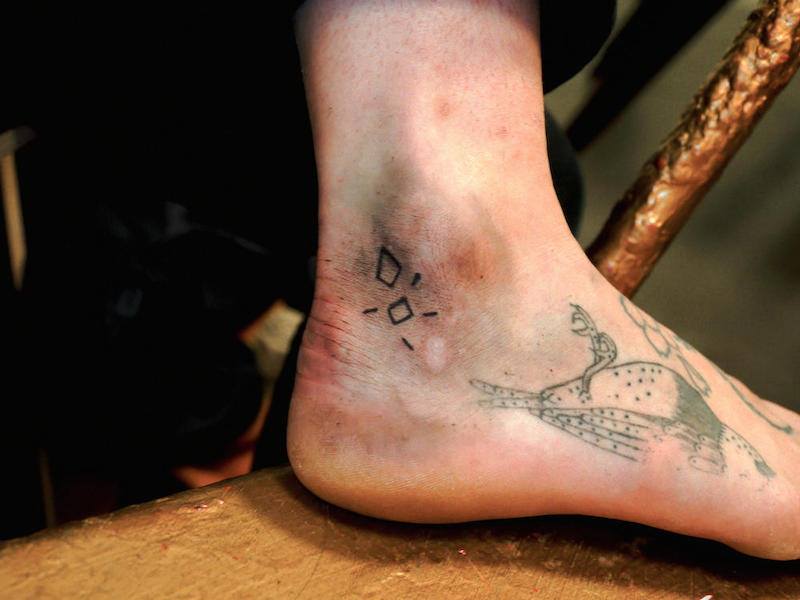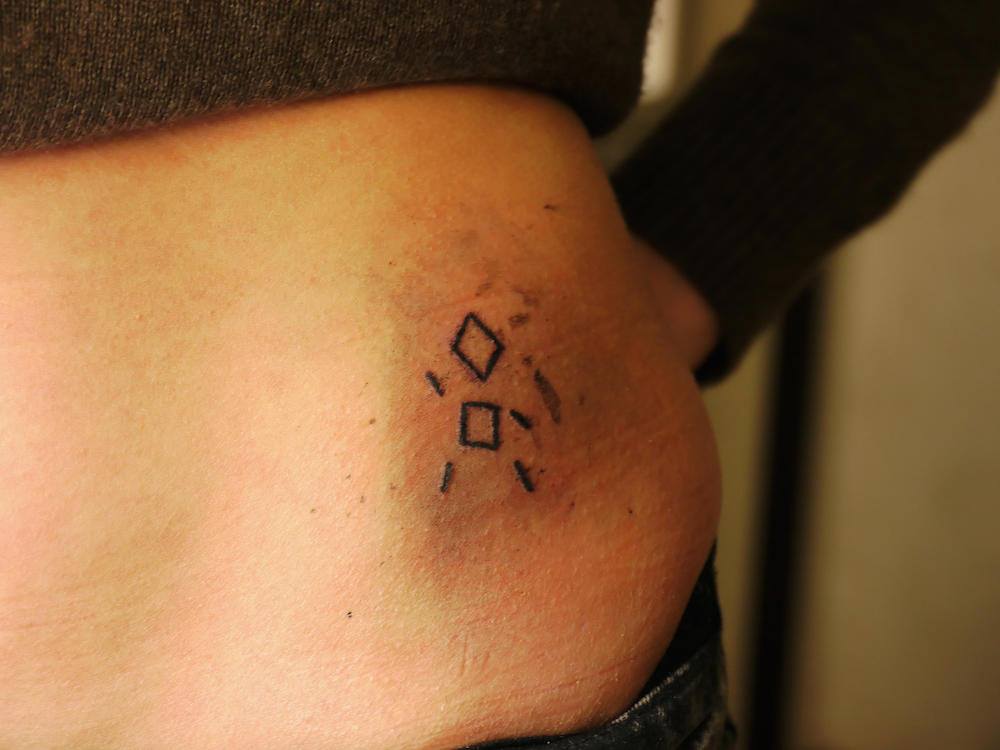When the tattoo is not a choice. Geometric Youth, a project by Frédéric Xavier Liver. //
Geometric Youth is a paradox. Although tattooing is a conscious and individual choice in contemporary culture, Frederic Xavier Liver removes any potential, personal decision, shifting his project into a collective ritual act, closed to its ancestral origins.
Tattooing has become a fashion as well as a mass phenomenon. The tattoo is a personal symbol on the skin and a way to make and produce community.
But what happens when there is no choice? When we are invited to be tattooed with only one possible choice of image?
When the Italian-French artist Frederic Xavier Liver, starts reflecting on the socio-anthropological value of the tattoo, he begins by re-defining the knowledge of what a tattoo is. Geometric Youth is a long-term performative project where the tattooist and the person who is tattooed, see their individual choices reduced to almost “0”. The artist, imposes only one possible choice: a geometric shape similar to an abstract human body made by two rhombuses, one smaller than the other, with some small lines below and on the sides.
It is an extremely simple and complex project at the same time. Conceptually and formally multi-layered, with the capacity to embrace a variety of different readings and actions. We can read Geometric Youth as a sort of palimpsest, a code, in its socio-anthropological nature. in which lies the determination to indelibly draw the traces of a process which, push every individual in front of a “choice” – the will of being tattooed rather than in the act of making an aesthetic preference.
When an individual engages with this choice and chooses to be tattooed, they voluntarily become part of a community. This is a community randomly formed through the instigation of a participatory mechanism. If the tattoo is indeed the expression of a unique, personal, intimate act with strong symbolic implications, both in terms of iconography and fashion, the pre-determined reduction of the choice generates a linguistic subversion in terms of signify and significance.
In fact, the final aesthetic outcome of the process is the result of a semiotic definition that aims to re-define what a tatto is. On the other hand, an aesthetic-performative mechanism which instigates the participation, reveals the capacity of build- ing a strong sense of community. The performative attitude of the project is in its conceptual nature, rather than the act of tattooing itself. The tattooist is, in fact, a sort of “tool”, anyone can be the tattooist, and what is crucial, is the active partici- pation of the people who are able to nurture the process and determine its success.
The performative attitude of the project is also determined by two more reasons: the first lies in its capacity to reveal social behaviour – those who accept being tattooed basically accept a symbol and becoming part of a community – the second is its capacity to shape a metaphorical place, as a bridge among different fields of knowledge (sociology, anthropology, art, cultural heritage so on so forth).
A bridge, able to determine different forms of thought and a different use of space. To be intended not only in its physi- cally but by referencing Lefebvre, in its ‘creative capacity’. A bridge able to subvert and re-negotiate the rules, by re-thinking and re-building the initial relationship in a tension that goes towards procedures and practices at the edge between
a subjective intentionality and a collective value. In this sense the content of the project goes even beyond its exclusive and self-referential field of belonging encouraging, thus, the public to actively interact with it contributing to write a different form of collective narration.
Claudio Zecchi
Geometric Youth is a paradox. Although tattooing is a conscious and individual choice in contemporary culture, Frederic Xavier Liver removes any potential, personal decision, shifting his project into a collective ritual act, closed to its ancestral origins.
Tattooing has become a fashion as well as a mass phenomenon. The tattoo is a personal symbol on the skin and a way to make and produce community.
But what happens when there is no choice? When we are invited to be tattooed with only one possible choice of image?
When the Italian-French artist Frederic Xavier Liver, starts reflecting on the socio-anthropological value of the tattoo, he begins by re-defining the knowledge of what a tattoo is. Geometric Youth is a long-term performative project where the tattooist and the person who is tattooed, see their individual choices reduced to almost “0”. The artist, imposes only one possible choice: a geometric shape similar to an abstract human body made by two rhombuses, one smaller than the other, with some small lines below and on the sides.
It is an extremely simple and complex project at the same time. Conceptually and formally multi-layered, with the capacity to embrace a variety of different readings and actions. We can read Geometric Youth as a sort of palimpsest, a code, in its socio-anthropological nature. in which lies the determination to indelibly draw the traces of a process which, push every individual in front of a “choice” – the will of being tattooed rather than in the act of making an aesthetic preference.
When an individual engages with this choice and chooses to be tattooed, they voluntarily become part of a community. This is a community randomly formed through the instigation of a participatory mechanism. If the tattoo is indeed the expression of a unique, personal, intimate act with strong symbolic implications, both in terms of iconography and fashion, the pre-determined reduction of the choice generates a linguistic subversion in terms of signify and significance.
In fact, the final aesthetic outcome of the process is the result of a semiotic definition that aims to re-define what a tatto is. On the other hand, an aesthetic-performative mechanism which instigates the participation, reveals the capacity of build- ing a strong sense of community. The performative attitude of the project is in its conceptual nature, rather than the act of tattooing itself. The tattooist is, in fact, a sort of “tool”, anyone can be the tattooist, and what is crucial, is the active partici- pation of the people who are able to nurture the process and determine its success.
The performative attitude of the project is also determined by two more reasons: the first lies in its capacity to reveal social behaviour – those who accept being tattooed basically accept a symbol and becoming part of a community – the second is its capacity to shape a metaphorical place, as a bridge among different fields of knowledge (sociology, anthropology, art, cultural heritage so on so forth).
A bridge, able to determine different forms of thought and a different use of space. To be intended not only in its physi- cally but by referencing Lefebvre, in its ‘creative capacity’. A bridge able to subvert and re-negotiate the rules, by re-thinking and re-building the initial relationship in a tension that goes towards procedures and practices at the edge between
a subjective intentionality and a collective value. In this sense the content of the project goes even beyond its exclusive and self-referential field of belonging encouraging, thus, the public to actively interact with it contributing to write a different form of collective narration.
Claudio Zecchi
Geometric Youth // Frédéric Xavier Liver
Le tatouage est un art ancestral qui signifiait bien des événements pour les hommes : des rapports privilégiés avec les dieux, des signes de guerre, des appartenances à des cultures oubliées, des rites de passages initiatiques, des marques de prisonniers, de légionnaires et pour les femmes, la prostitution ou la prison. Ce n’était pas rien d’être tatoué et cela même jusqu’aux années 1980. Puis le tatouage devint une mode de chanteurs de charme, de sportifs en goguette, dénuée de sens.
Désormais, n’importe qui à n’importe quel âge se fait tatouer n’importe quoi, n’importe où. Le tatouage s’est vulgarisé.
Là où l’on trouvait des signes forts, des affirmations sur le corps liées à toute une vie, à une histoire, une culture, un dépassement de soi, on trouve aujourd’hui des BD au dessus des fesses de jeunes filles pubères ou des barbus avec le bras rempli de signes dont ils ne comprennent pas le sens. La barbe et le tatouage sont en 2015 l’uniforme le plus répandu, un emballage vide et très occidental.
Frédéric Liver tatoue lui aussi, mais il ne fait pas du joli, ni du nouveau, il renoue avec le tatouage sociologique, culturel, signifiant, c’est à dire le tatouage d’antan, comme une marque au fer rouge, un signe cabalistique basique, commun, noir, réalisé avec un matériel rudimentaire qu’il a fabriqué.
Il laisse une trace indélébile, toujours la même, peu importe le tatoué, comme aux pires moments de l’histoire dans les camps nazis.
Il y a dans les tatouages de Frédéric Liver une solidarité avec les morts et les rescapés, une solidarité avec les putes d’antan, les prisonniers, les cultures oubliées. C’est un parti pris du pauvre, du rejeté, de l’exclu, une affirmation :la marque des esclaves conscients et solidaires.
Laurent Quenehen
Le tatouage est un art ancestral qui signifiait bien des événements pour les hommes : des rapports privilégiés avec les dieux, des signes de guerre, des appartenances à des cultures oubliées, des rites de passages initiatiques, des marques de prisonniers, de légionnaires et pour les femmes, la prostitution ou la prison. Ce n’était pas rien d’être tatoué et cela même jusqu’aux années 1980. Puis le tatouage devint une mode de chanteurs de charme, de sportifs en goguette, dénuée de sens.
Désormais, n’importe qui à n’importe quel âge se fait tatouer n’importe quoi, n’importe où. Le tatouage s’est vulgarisé.
Là où l’on trouvait des signes forts, des affirmations sur le corps liées à toute une vie, à une histoire, une culture, un dépassement de soi, on trouve aujourd’hui des BD au dessus des fesses de jeunes filles pubères ou des barbus avec le bras rempli de signes dont ils ne comprennent pas le sens. La barbe et le tatouage sont en 2015 l’uniforme le plus répandu, un emballage vide et très occidental.
Frédéric Liver tatoue lui aussi, mais il ne fait pas du joli, ni du nouveau, il renoue avec le tatouage sociologique, culturel, signifiant, c’est à dire le tatouage d’antan, comme une marque au fer rouge, un signe cabalistique basique, commun, noir, réalisé avec un matériel rudimentaire qu’il a fabriqué.
Il laisse une trace indélébile, toujours la même, peu importe le tatoué, comme aux pires moments de l’histoire dans les camps nazis.
Il y a dans les tatouages de Frédéric Liver une solidarité avec les morts et les rescapés, une solidarité avec les putes d’antan, les prisonniers, les cultures oubliées. C’est un parti pris du pauvre, du rejeté, de l’exclu, une affirmation :la marque des esclaves conscients et solidaires.
Laurent Quenehen

































































































